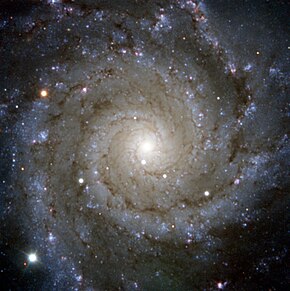| Messier 74 | |
|---|---|
 The spiral galaxy M74 (in the left bottom corner is the supernova SN 2013ej) | |
| Observation data (J2000 epoch) | |
| Constellation | Pisces[1] |
| Right ascension | 01h 36m 41.8s[2] |
| Declination | +15° 47′ 01″[2] |
| Redshift | 657 km/s[2] |
| Distance | 30 ± 6 Mly[3] |
| Apparent magnitude (V) | 9.4[4] |
| Characteristics | |
| Type | SA(s)c[2] |
| Number of stars | 100 billion (1×1011) |
| Size | 95,000 ly (diameter)[5] |
| Apparent size (V) | 10′.5 × 9′.5[2] |
| Other designations | |
| NGC 628, UGC 1149, PGC 5974[2] | |
Messier 74 (also known as NGC 628 and Phantom Galaxy) is a large spiral galaxy in the equatorial constellation Pisces.[a] It is about 32 million light-years away from Earth.[6] The galaxy contains two clearly defined spiral arms and is therefore used as an archetypal example of a grand design spiral galaxy.[7] The galaxy's low surface brightness makes it the most difficult Messier object for amateur astronomers to observe.[8][9] Its relatively large angular (that is, apparent) size and the galaxy's face-on orientation make it an ideal object for professional astronomers who want to study spiral arm structure and spiral density waves. It is estimated that M74 hosts about 100 billion stars.[6]
- ^ R. W. Sinnott, ed. (1988). The Complete New General Catalogue and Index Catalogue of Nebulae and Star Clusters by J. L. E. Dreyer. Sky Publishing Corporation / Cambridge University Press. ISBN 978-0-933346-51-2.
- ^ a b c d e f Cite error: The named reference
nedwas invoked but never defined (see the help page). - ^ Cite error: The named reference
hendryetal2005was invoked but never defined (see the help page). - ^ "Messier 74". SEDS Messier Catalog. Archived from the original on 27 June 2023. Retrieved 30 April 2022.
- ^ "Messier Object 74".
- ^ a b Nemiroff, R.; Bonnell, J., eds. (2011-04-06). "M74: The Perfect Spiral". Astronomy Picture of the Day. NASA. Retrieved 2011-04-07.
- ^ A. Sandage; J. Bedke (1994). Carnegie Atlas of Galaxies. Carnegie Institution of Washington. ISBN 978-0-87279-667-6.
- ^ S. J. O'Meara (1998). The Messier Objects. Cambridge University Press. ISBN 978-0-521-55332-2.
- ^ K. G. Jones (1991). Messier's Nebulae and Star Clusters (2nd ed.). Cambridge: Cambridge University Press. ISBN 978-0-521-37079-0.
Cite error: There are <ref group=lower-alpha> tags or {{efn}} templates on this page, but the references will not show without a {{reflist|group=lower-alpha}} template or {{notelist}} template (see the help page).